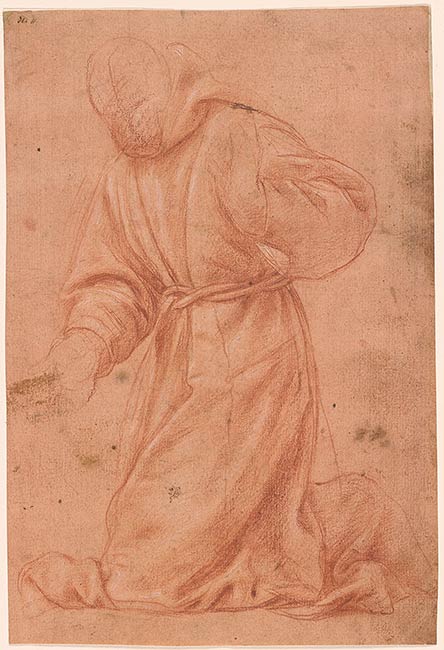
Watermark: none visible through lining.
Long associated with Tanzio's altarpiece of the "Virgin and Child with Sts. Carlo Borromeo and Francis," formerly in the Oratorio San Carlo at Sabbia, Valsesia, and now in the Pinacoteca at Varallo, this study is even closer to the figure of St. Francis in a version of that painting, the "Adoration of the Shepherds with Sts. Carlo Borromeo and Francis" now at the Los Angeles County Museum of Art, inv. M.81.247. Tanzio often reused figures and compositions in this manner. Documents show that the Sabbia painting was executed sometime between 1628 and 1632 (see Rosci, "Two Altar-Pieces by Tanzio da Varallo," Burlington Magazine 101 (1959), 182-86), but the LACMA painting--though usually dated ca. 1628 by association with the Sabbia altarpiece--is more recently considered a work of the early 1620s (see Enrica Pagella, in the 2000 Tanzio da Varallo exhibition catalogue, under no. 27, citing F. Frangi, “Itinerario di Tanzio da Varallo,” in Percorsi caravaggeschi tra Roma e Piemonte, 1999, pp. 145-46). The fact that the Morgan drawing coincides more closely with the LACMA painting, suggesting that the figure was first worked out for this painting, is further support for dating that canvas earlier than the Sabbia altarpiece.
This sheet comes from a group of drawings by Tanzio that was assembled possibly by the artist or else by an early collector, perhaps Bartolomeo Carlo Borsetti, who may have received the drawings from the artist's heirs. Sheets formerly in the set, which probably made up an album, are characterized by the numbering seen at upper left ("n. 4” in the case of the Scholz drawing). Some of these were later in the collection of the Milanese dealer Giuseppe Vallardi (and others in the Milanese collections of Francesco Dubini and of Giovanni Morelli), and bear Vallardi's inscribed inventory numbers on the verso, though many (including the Scholz drawing) do not. Most of the sheets from the set (whether they have the Vallardi number or not) can be traced to one or another Swiss owner in the mid-twentieth century. It seems plausible that the group passed through Milan but that a core of it remained intact until dispersed by a Swiss dealer. According to a note on the old mount, Janos Scholz acquired his drawing from in Zurich in 1948, and Scholz noted on his inventory card that it “comes from a large lot of drawings by Tanzio, sold in Zurich,” but it is not clear whether Meissner handled the entire group. For details on the dispersed album of which the drawing was once part, see S. Bareggi and F. Ferro, “Alcuni disegni inediti di Tanzio da Varallo,” Paragone 112, 765 (2013): 32-41, as well as Michael Matile, Zwiegespräch mit Zeichnungen. Werke des 15. bis 18. Jahrhunderts aus der Sammlung Robert Landolt, exh. cat., Zurich: Graphische Sammlung ETH, 2013-14, nos. 32-33. Additional examples--also with Swiss provenance--have recently come to auction at Sotheby's, New York, 30 January 2019, and at Christie's, London, 8 December 2020.
Inscribed in upper left corner, in pen and brown ink, "n. 4".
Scholz, János, former owner.
Scholz, Janos. Italian Master Drawings, 1350-1800, from the János Scholz Collection. New York : Dover, 1976, no. 67, repr.
Ryskamp, Charles, ed. Nineteenth Report to the Fellows of the Pierpont Morgan Library, 1978-1980. New York : Pierpont Morgan Library, 1981, p. 188.
